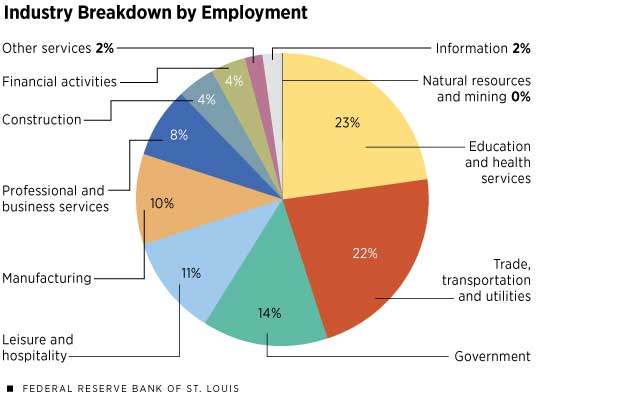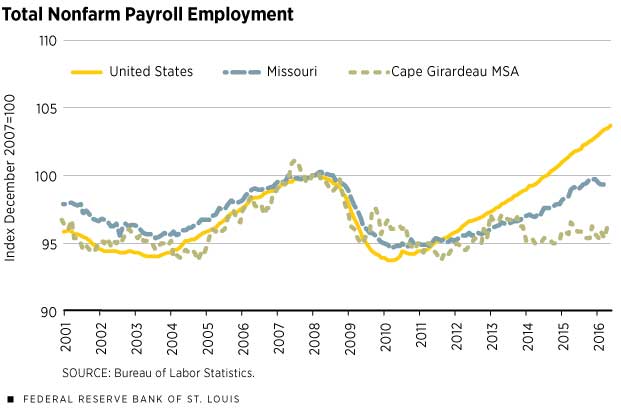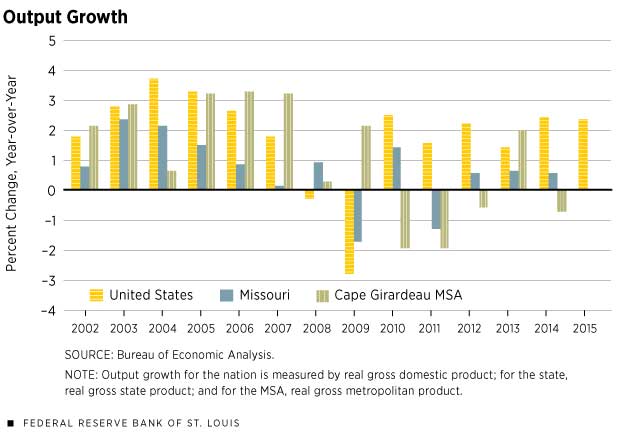Some Sectors Are Strong in Cape Girardeau, but Recovery from Recession Remains Elusive
The city of Cape Girardeau sits along the Mississippi River in southeastern Missouri. During the steamboat era, the city boomed, becoming the busiest port between St. Louis and Memphis. Today, the port remains an active part of the community, handling more than 1 million tons per year.
The city is the center of the three-county region called the Cape Girardeau-Jackson metropolitan statistical area (MSA). Of the three counties in the MSA, Cape Girardeau County contains about 80 percent of the MSA's population, with half of those residents living in the city of Cape Girardeau.
The population of the entire MSA was just under 100,000 in 2015. Growth over the previous 10 years was a modest 4.7 percent, about the same as for the state overall. The nation's population grew 8.8 percent over the same period. The local growth was concentrated entirely in Cape Girardeau County; the other two counties—Bollinger in Missouri and Alexander in Illinois—experienced population declines of 2.3 percent and 23.9 percent, respectively.
Employment
Total employment in the metro area was about 44,000 in 2015, or 44 percent of the region's population, a percentage nearly identical to that of the state and nation. As expected, most of these employees work in Cape Girardeau County. About 25 percent of the county workforce commutes in from outside counties. Many of the workers live outside the MSA; they make up 18 percent of the Cape Girardeau County workforce.
Historically, many Midwestern cities relied on the manufacturing sector to drive the economy. However, the makeup of Cape Girardeau today is largely that of a diversified, service-sector economy. The fraction of Cape Girardeau MSA employees who work in manufacturing is about 10 percent, only slightly greater than the national average. Nonetheless, manufacturing plays a prominent role in the local economy, with Procter & Gamble being the third largest employer in the region.
One sector where the metro area does have a larger employee concentration than does the nation is the health care and social assistance sector. As of 2015, about 9,000 employees worked in this industry—just under a quarter of the region's employment and a share that is about 1.7 times the national average. Over half of these workers are employed by the region's two largest employers: St. Francis Healthcare System and SoutheastHEALTH, both of which serve the area through multiple locations and have their main facilities in the city.
Education also plays a significant role in the economy, largely due to Southeast Missouri State University, which is in the city of Cape Girardeau. The university has an enrollment of about 12,000 students; with 1,107 employees, it is the fourth-largest employer in the region.
The health care and education industry steadily added jobs during and after the Great Recession (2007-09), making it a vital source of economic growth over the last decade.
Output, Productivity and Income
Annual output of all goods and services produced in the Cape Girardeau MSA was $3.4 billion in 2014 (measured by real gross metropolitan product). This is 1.3 percent of Missouri's total output and 2.5 percent of the St. Louis MSA's. In comparison, 2014 output for the nearby Carbondale-Marion MSA in Illinois was $4.3 billion.
Total output per worker in the Cape Girardeau MSA is approximately $80,000, about 16 percent lower than the state average of $96,000 and 32 percent below the U.S. average of $117,000. This lower level of productivity is consistent with the lower level of wages and income in the region. Total wages per employee in the MSA were $36,000, which is 18 percent lower than the state average of $44,000 and 29 percent below the national average of $51,000. Per capita income (which includes other sources of income and is calculated based on the entire population, not just workers) follows a similar pattern: $38,000 for the MSA, $42,000 for Missouri and $46,000 for the nation.
One of the key factors explaining the differences in productivity (and earnings) across regions is the skill level of the workforce (measured by educational attainment). However, the educational attainment gap between the Cape Girardeau region and the nation is small. In the MSA, 86 percent of the population 25 and older has at least graduated from high school and 24 percent of the same population has at least a bachelor's degree. The national averages are 86 percent and 29 percent, respectively.
Given this lack of gap in the observed skill level, there must be other explanations for the earnings gap. Economists have found a strong positive relationship between wages and city size—a 1 percent increase in wages for each additional 100,000 people.1 For example, the model would project that if Cape had a population of 2.8 million people (like St. Louis), wages per employee would be about $48,000. Actual wages per employee in St. Louis are about $49,000.
Nonetheless, incomes should be adjusted for a household's cost of living when measuring economic well-being, and with the smaller city size comes a lower overall cost of living. Based on regional price parity measures, the prices in the MSA are 16 percent cheaper than the national average, 7 percent lower than those in the St. Louis MSA and 6 percent lower than those for Missouri overall. After adjusting for the regional cost of living, real personal income per capita for the MSA is nearly $45,000, slightly below the U.S. average of $46,000.
Low housing costs are the main driver behind the region's low cost of living. Rent in the Cape Girardeau MSA is 32 percent lower than the U.S. average. As of 2014, the median house price in the MSA was $126,000, 28 percent below the national average. Buying a home in the MSA is still relatively more affordable even after taking into account differences in income, as the median house in Cape Girardeau costs just 2.9 times the median household income; for the nation, that figure is 3.3 times.
Aside from being affordable, housing prices in the MSA have also been relatively stable over the past decade compared with those in the rest of the country. House prices increased 4 percent during the boom years from 2004-2007, when U.S. prices climbed 24 percent. Local prices fell by only 5 percent during the Great Recession, while national housing prices dropped by more than 19 percent.
Recovery or Stagnation?
Before the Great Recession, the MSA experienced moderate growth of real output, with an average growth rate of 2.6 percent per year from 2001 to 2007, close to the nation's growth rate and double that of Missouri. However, since then, the region's economy has stagnated, with real output declining by an average of 0.1 percent per year from 2007 to 2014. This trend is consistent with Missouri's lackluster average annual growth of 0.2 percent during that time; in comparison, the nation's average for this period has been 1 percent.
Employment has followed a similar trend. Payroll employment in the MSA increased 0.9 percent per year from 2001 to 2007, the same rate as that of the nation and slightly higher than that of Missouri. During the recession, the MSA lost about 2,000 jobs. The area has yet to recover these jobs; total employment has remained essentially flat since 2009, when the recession officially ended. In contrast, employment levels in Missouri and the nation are approaching and surpassing their prerecession peaks, respectively.
Several industries have shown signs of growth since 2009 even though overall employment has been flat. The health care services industry continues to be a strong driver of growth. However, the most growth in recent years has come from the leisure and hospitality sector. To encourage that growth, the city is constructing a new conference center and related amenities. These projects are attempts to boost the city tourism in the slow winter months.
Joseph T. McGillicuddy is a research associate at the Bank.
MSA Snapshot
Cape Girardeau, Mo.
| POPULATION |
97,534
|
| POPULATION GROWTH (2010-2015) |
1.13%
|
| PERCENTAGE WITH BACHELOR'S DEGREE OR HIGHER | 24% |
| PERCENTAGE WITH A HS DEGREE OR HIGHER |
86%
|
| PER CAPITA PERSONAL INCOME |
$37,507
|
| MEDIAN HOUSEHOLD INCOME |
$43,415
|
| UNEMPLOYMENT RATE (DECEMBER) | 4.5% |
| REAL GMP (2014) | $3.45 BILLION |
| GMP GROWTH (2014) | –0.66% |
Largest Employers
| ST. FRANCIS HEALTHCARE SYSTEM |
2,817
|
| SOUTHEASTHEALTH |
2,430
|
| PROCTER & GAMBLE PAPER PRODUCTS |
1,200
|
| SOUTHEAST MISSOURI STATE UNIVERSITY |
1,107
|
| CAPE GIRARDEAU PUBLIC SCHOOLS |
713
|


Views expressed in Regional Economist are not necessarily those of the St. Louis Fed or Federal Reserve System.
For the latest insights from our economists and other St. Louis Fed experts, visit On the Economy and subscribe.
Email Us







